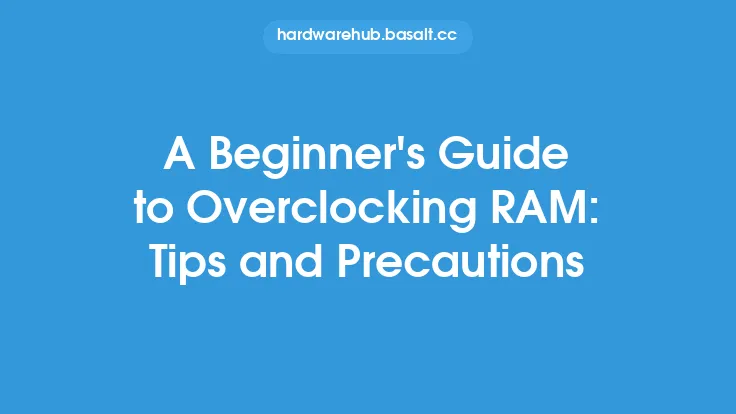When it comes to RAM overclocking, one of the most critical aspects to consider is the timings of the memory modules. RAM timings, also known as latency, refer to the time it takes for the memory to respond to a request from the system. Understanding RAM timings and their impact on overclocking is essential to achieve optimal performance and stability.
Introduction to RAM Timings
RAM timings are measured in clock cycles, and they are typically represented by a series of four numbers: CAS Latency (CL), RAS-to-CAS Delay (tRCD), RAS Precharge (tRP), and RAS Active Time (tRAS). These numbers indicate the time it takes for the memory to perform specific operations, such as accessing a row of memory cells, reading or writing data, and precharging the memory array. For example, a RAM module with timings of 16-18-18-36 means that it has a CAS Latency of 16 clock cycles, a RAS-to-CAS Delay of 18 clock cycles, a RAS Precharge of 18 clock cycles, and a RAS Active Time of 36 clock cycles.
How RAM Timings Affect Overclocking
When overclocking RAM, the goal is to increase the memory frequency while maintaining or improving the timings. However, as the frequency increases, the timings often become looser, which can negatively impact performance. This is because the memory controller has to wait longer for the memory to respond, which can lead to increased latency and decreased bandwidth. To mitigate this, overclockers often try to tighten the timings while increasing the frequency, which can be a challenging and delicate process.
CAS Latency (CL) and Its Impact on Overclocking
CAS Latency, or CL, is the most critical timing when it comes to RAM overclocking. It represents the time it takes for the memory to respond to a read or write request. A lower CL indicates faster access times and improved performance. When overclocking, it's essential to balance the CL with the frequency, as a lower CL at a higher frequency can result in improved performance, but a higher CL at the same frequency can lead to decreased performance.
RAS-to-CAS Delay (tRCD) and RAS Precharge (tRP)
The RAS-to-CAS Delay (tRCD) and RAS Precharge (tRP) timings are also crucial when it comes to RAM overclocking. tRCD represents the time it takes for the memory to switch from one row of memory cells to another, while tRP represents the time it takes for the memory to precharge the array after a read or write operation. Tightening these timings can improve performance, but it can also increase the risk of instability and errors.
RAS Active Time (tRAS) and Its Impact on Overclocking
The RAS Active Time (tRAS) timing represents the time it takes for the memory to activate a row of memory cells. A lower tRAS can improve performance, but it can also increase the risk of instability and errors. When overclocking, it's essential to balance the tRAS with the other timings, as a lower tRAS can result in improved performance, but a higher tRAS can lead to decreased performance.
Command Rate and Its Impact on Overclocking
The command rate, also known as the command time, represents the time it takes for the memory controller to issue a command to the memory. A lower command rate can improve performance, but it can also increase the risk of instability and errors. When overclocking, it's essential to balance the command rate with the other timings, as a lower command rate can result in improved performance, but a higher command rate can lead to decreased performance.
Overclocking RAM Timings: A Delicate Balance
Overclocking RAM timings is a delicate balance between frequency, latency, and stability. As the frequency increases, the timings often become looser, which can negatively impact performance. To mitigate this, overclockers often try to tighten the timings while increasing the frequency, which can be a challenging and delicate process. The key is to find the optimal balance between frequency, latency, and stability, which can result in improved performance and responsiveness.
Conclusion
In conclusion, understanding RAM timings and their impact on overclocking is essential to achieve optimal performance and stability. By balancing the CAS Latency, RAS-to-CAS Delay, RAS Precharge, RAS Active Time, and command rate, overclockers can improve the performance and responsiveness of their system. However, it's essential to remember that overclocking RAM timings is a delicate balance, and pushing the limits too far can result in instability and errors. By following the guidelines outlined in this article, overclockers can unlock the full potential of their RAM and achieve improved performance and responsiveness.





